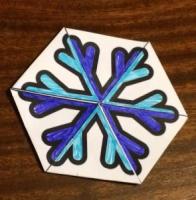Blog
2016-03-15
This article first appeared in
issue 03 of
Chalkdust. I highly recommend reading the rest of the magazine (and trying
to solve the crossnumber I wrote for the issue).
It all began in December 1956, when an article about hexaflexagons was published in Scientific American. A hexaflexagon is a
hexagonal paper toy which can be folded and then opened out to reveal hidden faces. If you have never made a hexaflexagon, then you should stop
reading and make one right now. Once you've done so, you will understand why the article led to a craze in New York;
you will probably even create your own mini-craze because you will just need to show it to everyone you know.
The author of the article was, of course, Martin Gardner.
Martin Gardner was born in 1914 and grew up in Tulsa, Oklahoma. He earned a bachelor's degree in philosophy from the University of Chicago and
after four years serving in the US Navy during the Second World War, he returned to Chicago and began writing. After a few years working on
children's magazines and the occasional article for adults, Gardner was introduced to John Tukey, one of the students who had been involved in
the creation of hexaflexagons.
Soon after the impact of the hexaflexagons article became clear, Gardner was asked if he had enough material to maintain a monthly column.
This column, Mathematical Games, was written by Gardner every month from January 1956 for 26 years until December 1981. Throughout its run,
the column introduced the world to a great number of mathematical ideas, including Penrose tiling, the Game of Life, public key encryption,
the art of MC Escher, polyominoes and a matchbox machine learning robot called MENACE.
Life
Gardner regularly received topics for the column directly from their inventors. His collaborators included Roger Penrose, Raymond Smullyan,
Douglas Hofstadter, John Conway and many, many others. His closeness to researchers allowed him to write about ideas that
the general public were previously unaware of and share newly researched ideas with the world.
In 1970, for example, John Conway invented the Game of Life, often simply referred to as Life. A few weeks later, Conway showed the game to Gardner, allowing
him to write the first ever article about the now-popular game.
In Life, cells on a square lattice are either alive (black) or dead (white). The status of the cells in the next generation of the game is given by the following
three rules:
- Any live cell with one or no live neighbours dies of loneliness;
- Any live cell with four or more live neighbours dies of overcrowding;
- Any dead cell with exactly three live neighbours becomes alive.
For example, here is a starting configuration and its next two generations:
The collection of blocks on the right of this game is called a glider, as it will glide to the right and upwards as the generations advance.
If we start Life with a single glider, then the glider will glide across the board forever, always covering five squares: this starting position
will not lead to the sad ending where everything is dead. It is not obvious, however, whether there is a starting
configuration that will lead the number of occupied squares to increase without bound.
Originally, Conway and Gardner thought that this was impossible, but after the article was published, a reader and mathematician called Bill Gosper
discovered the glider gun: a starting arrangement in Life that fires a glider every 30 generations. As each of these gliders will go on to live
forever, this starting configuration results in the number of live cells
perpetually increasing!
This discovery allowed Conway to prove that any Turing machine can be built within Life: starting
arrangements exist that can calculate the digits of pi, solve equations, or do any other calculation a computer is capable of (although very slowly)!
Encrypting with RSA
To encode the message \(809\), we will use the public key:
$$s=19\quad\text{and}\quad r=1769$$
The encoded message is the remainder when the message to the power of \(s\) is divided by \(r$:
$$809^{19}\equiv\mathbf{388}\mod1769$$
Decrypting with RSA
To decode the message, we need the two prime factors of \(r\) (\(29\) and \(61\)).
We multiply one less than each of these together:
\begin{align*}
a&=(29-1)\times(61-1)\\[-2pt]
&=1680.
\end{align*}
We now need to find a number \(t\) such that \(st\equiv1\mod a\). Or in other words:
$$19t\equiv1\mod 1680$$
One solution of this equation is \(t=619\) (calculated via the extended Euclidean algorithm).
Then we calculate the remainder when the encoded message to the power of \(t\) is divided by \(r\):
$$388^{619}\equiv\mathbf{809}\mod1769$$
RSA
Another concept that made it into Mathematical Games shortly after its discovery was public key cryptography. In mid-1977, mathematicians Ron
Rivest, Adi Shamir and Leonard Adleman invented the method of encryption now known as RSA (the initials of their surnames). Here,
messages are encoded using two publicly shared numbers, or keys. These numbers and the method used to encrypt messages can be publicly shared as
knowing this information does not reveal how to decrypt the message. Rather, decryption of the message requires knowing the prime factors of one of the keys. If this key is the product of two very large
prime numbers, then this is a very difficult task.
Something to think about
Gardner had no education in maths beyond high school, and at times had difficulty understanding the material he was writing about. He believed, however, that this was a strength and not a weakness: his struggle to understand led him to write in a way that other non-mathematicians could follow. This goes a long way to explaining the popularity of his column.
After Gardner finished working on the column, it was continued by Douglas Hofstadter and then AK Dewney before being passed down to Ian Stewart.
Gardner died in May 2010, leaving behind hundreds of books and articles. There could be no better way to end than with something for you to go
away and think about. These of course all come from Martin Gardner's Mathematical Games:
- Find a number base other than 10 in which 121 is a perfect square.
- Why do mirrors reverse left and right, but not up and down?
- Every square of a 5-by-5 chessboard is occupied by a knight.
- Is it possible for all 25 knights to move simultaneously in such a way that at the finish all cells are still occupied as before?
(Click on one of these icons to react to this blog post)
You might also enjoy...
Comments
Comments in green were written by me. Comments in blue were not written by me.
Add a Comment
2015-08-27
In 1961, Donald Michie built MENACE (Machine Educable Noughts And Crosses Engine), a machine capable of learning to be a better player of Noughts and Crosses (or Tic-Tac-Toe if you're American). As computers were less widely available at the time, MENACE was built from from 304 matchboxes.
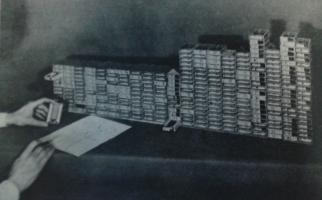
Taken from Trial and error by Donald Michie [2]
The original MENACE.
To save you from the long task of building a copy of MENACE, I have written a JavaScript version of MENACE, which you can play against here.
How to play against MENACE
To reduce the number of matchboxes required to build it, MENACE always plays first. Each possible game position which MENACE could face is drawn on a matchbox. A range of coloured beads are placed in each box. Each colour corresponds to a possible move which MENACE could make from that position.
To make a move using MENACE, the box with the current board position must be found. The operator then shakes the box and opens it. MENACE plays in the position corresponding to the colour of the bead at the front of the box.
For example, in this game, the first matchbox is opened to reveal a red bead at its front. This means that MENACE (O) plays in the corner. The human player (X) then plays in the centre. To make its next move, MENACE's operator finds the matchbox with the current position on, then opens it. This time it gives a blue bead which means MENACE plays in the bottom middle.
The human player then plays bottom right. Again MENACE's operator finds the box for the current position, it gives an orange bead and MENACE plays in the left middle. Finally the human player wins by playing top right.
MENACE has been beaten, but all is not lost. MENACE can now learn from its mistakes to stop the happening again.
How MENACE learns
MENACE lost the game above, so the beads that were chosen are removed from the boxes. This means that MENACE will be less likely to pick the same colours again and has learned. If MENACE had won, three beads of the chosen colour would have been added to each box, encouraging MENACE to do the same again. If a game is a draw, one bead is added to each box.
Initially, MENACE begins with four beads of each colour in the first move box, three in the third move boxes, two in the fifth move boxes and one in the final move boxes. Removing one bead from each box on losing means that later moves are more heavily discouraged. This helps MENACE learn more quickly, as the later moves are more likely to have led to the loss.
After a few games have been played, it is possible that some boxes may end up empty. If one of these boxes is to be used, then MENACE resigns. When playing against skilled players, it is possible that the first move box runs out of beads. In this case, MENACE should be reset with more beads in the earlier boxes to give it more time to learn before it starts resigning.
How MENACE performs
In Donald Michie's original tournament against MENACE, which lasted 220 games and 16 hours, MENACE drew consistently after 20 games.
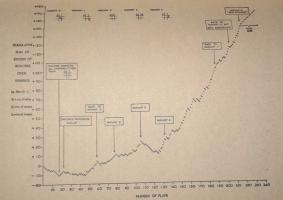
Taken from Trial and error by Donald Michie [2]
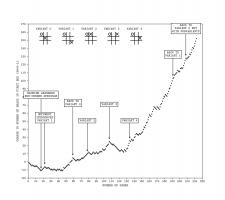
Graph showing MENACE's performance in the original tournament. Edit: Added the redrawn graph on the left.
After a while, Michie tried playing some more unusual games. For a while he was able to defeat MENACE, but MENACE quickly learnt to stop losing. You can read more about the original MENACE in A matchbox game learning-machine by Martin Gardner [1] and Trial and error by Donald Michie [2].
You may like to experiment with different tactics against MENACE yourself.
Play against MENACE
I have written a JavaScript implemenation of MENACE for you to play against. The source code for this implementation is available on GitHub.
When playing this version of MENACE, the contents of the matchboxes are shown on the right hand side of the page. The numbers shown on the boxes show how many beads corresponding to that move remain in the box. The red numbers show which beads have been picked in the current game.
The initial numbers of beads in the boxes and the incentives can be adjusted by clicking Adjust MENACE's settings above the matchboxes. My version of MENACE starts with more beads in each box than the original MENACE to prevent the early boxes from running out of beads, causing MENACE to resign.
Additionally, next to the board, you can set MENACE to play against random, or a player 2 version of MENACE.
Edit: After hearing me do a lightning talk about MENACE at CCC, Oliver Child built a copy of MENACE. Here are some pictures he sent me:

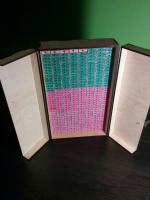
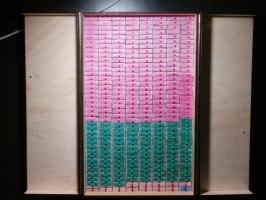
Edit: Oliver has written about MENACE and the version he built in issue 03 of Chalkdust Magazine.
Edit: Inspired by Oliver, I have built my own MENACE. I took it to the MathsJam Conference 2016. It looks like this:

References
[2] Trial and error by Donald Michie. Penguin Science Survey, 1961.
(Click on one of these icons to react to this blog post)
You might also enjoy...
Comments
Comments in green were written by me. Comments in blue were not written by me.
One day a sentient super general AI is going to stumble upon this page and consider it the origin of life.
Mark Hartnady
This is very neat. I wonder how long it would take to use that many matches to get all those match boxes.
Duke Nukem
"When playing against skilled players, it is possible that the first move box runs out of beads. In this case, MENACE should be reset with more beads in the earlier boxes to give it more time to learn before it starts resigning."
If someone were doing this, you could do this automatically to avoid the perception or temptation of the operator to help it along. Instead of "oh, it's dead, let's repopulate the boxes", you could just make it part of the inter-game cleanup, like a garbage collection routine. After all the bead deleting/adding whatever, but before the next game starts, look at all the boxes, make sure that each box contains at least one of each color. Now this weakens the learning algorithm moderately, but it guarantees that it will never get stuck.
If someone were doing this, you could do this automatically to avoid the perception or temptation of the operator to help it along. Instead of "oh, it's dead, let's repopulate the boxes", you could just make it part of the inter-game cleanup, like a garbage collection routine. After all the bead deleting/adding whatever, but before the next game starts, look at all the boxes, make sure that each box contains at least one of each color. Now this weakens the learning algorithm moderately, but it guarantees that it will never get stuck.
(anonymous)
@(anonymous): Yes, those boxes are for O being MENACE and MENACE playing first
Matthew
@Matthew: Thank you for such a quick response. Just to let you know that that link did not work after .../tree/master/output, but I managed to search around for the right files :). In these files MENACE plays the Nought right? and the user plays the Cross?
(anonymous)
Add a Comment

